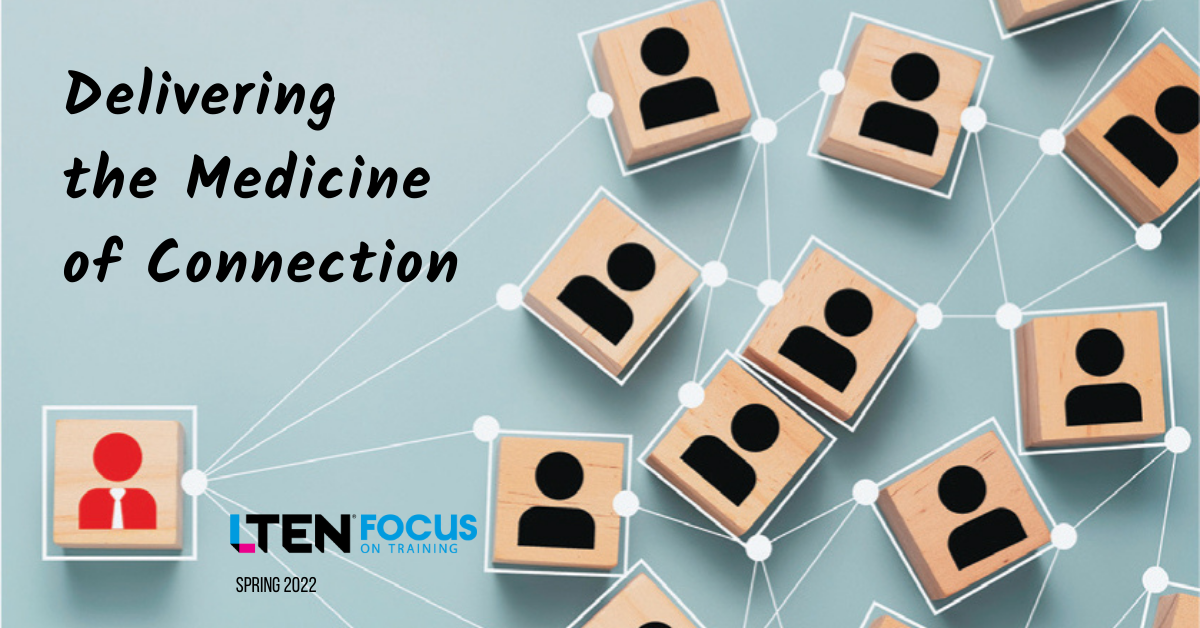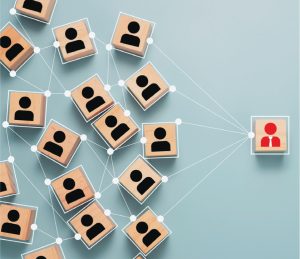
Delivering the Medicine of Connection
Working & Living Well – Deborah Bonzell
Social disconnection is a problem, but the antidote is delivered in simple ways
 As more of us struggle with social isolation and loneliness, small shifts in how you engage with your learners can make a big difference.
As more of us struggle with social isolation and loneliness, small shifts in how you engage with your learners can make a big difference.
Imagine this: You’re sitting at your computer reviewing participant feedback from your last virtual workshop. You felt the session went well overall — your material was solid, the technology worked smoothly, there was a lively exchange in chat and you ended on time.
You scroll past the ratings to the ‘additional comments’ section at the end and see that six out of 10 attendees wrote the same thing in the open text field: “The facilitator didn’t seem to care about me as a person.”
Whoa, what?
As you’ve probably already guessed, this scenario is fictitious. However, the underlying facts are sadly all too true.
The Epidemic of Loneliness
It’s no secret — workplace well-being has been declining steadily over the past decade, and the pandemic has made a bad situation even worse. One of the most heartbreaking trends is the alarming rise of loneliness and social disconnection at work, which has been quantified in ways that are hard to ignore.
For example, Gallup reported in 2019 that only four in 10 Americans strongly agree that someone at work seems to care about them as a person. (This is the statistic that inspired the scenario I asked you to imagine a minute ago.)
Similar research by Cigna found that more than one in three U.S. employees feels a general sense of emptiness or disconnection from others when at work.
In terms of productivity, there is (not surprisingly) a strong correlation between loneliness and under-performance. The lonelier people are, the lower their ratings from their immediate supervisors.
And finally, when it comes to health outcomes, loneliness has been shown to be as hazardous as smoking 15 cigarettes a day, making it a greater risk to our well-being than obesity, excess alcohol consumption and lack of exercise.
The Science of Connection
Now, for some good news. While social disconnection is a big problem, the antidote can be delivered in small, simple ways — by strangers, colleagues and loved ones alike. What’s more, moments of connection can have an immediate, positive impact on our physiology and mood.
As humans, we are born with a hard-wired instinct to connect, and our biology rewards us when we do in the form of oxytocin — the so-called “cuddle hormone” that promotes bonding and attachment. Using fMRI scans, social connection has been shown to activate the same circuits in our brains that detect physical pleasure. Connection also triggers a positive immune response, aiding in recovery from illness and injury.
Recall the last time you had a brief-yet-satisfying exchange with someone at the grocery store or walking in your neighborhood; that simultaneously calmenergized-joyful feeling you had right afterward? That was the medicine of connection in action.
Delivering Care + Content
Which brings us to the all-important question: What can you do to offer your participants a higher dose of connection and care while still delivering impactful training/education material in a time-efficient manner?
Here are three small shifts I’ve made in my own facilitation efforts, which seem to be yielding positive results. Consider them a starting point for your own reflection and experimentation.
- Start building community before skill. As Abraham Maslow’s famous model reminds us, people need to feel physically and psychologically safe before they can engage in the higher order tasks of learning and growth. In today’s world, this is hardly a given. The answer? Roll out the welcome mat. Greet people by name, invite them to say hello to one another, perhaps mine for some shared interests or goals. When you do this before diving into the agenda, you establish a safe and trusting container in which people feel seen, heard and included.
- Minimize slides, maximize faces. Yes, PowerPoint is a useful tool; it can also be a barrier to social connection. Why? Because our brains cannot multi-task. When we are focused on the slide show, we miss the human show of eye contact, body language and tone — all the “mechanisms of action” that help us connect. The fix? Pare down your training decks to the vital few slides that truly represent your visual aids (versus your notes). Whenever possible, use images instead of words — particularly human faces and nature scenes — and stop sharing when you want to invite discussion. A streamlined slide approach helps keep people at the center of the experience.
- Ask more, tell less. Finally, it’s important to remind ourselves that we are humans first and subject matter experts second. This means we’re off the hook to have all the answers and do things perfectly. Because life happens, and we often have no idea what other people are really thinking and feeling in a particular moment. How do we find out? By pausing frequently to ask questions and having the courage to model vulnerability when you make a mistake or don’t know something. When you make your own thoughts and emotions visible to others, you give permission to others (particularly those who are hungry for connection) to do the same.
Learn More from Deb
Interested in taking a deeper dive into the topic of this article? Join Deborah Bonzell for a 30-minute webinar, Well-Being Rx: The Medicine of Connection on Friday, March 11th at 12:30 p.m. ET. Visit www.L-TEN.org/webinars to register and join the conversation.
Want to hear more about other well-being practices besides connection that can help you and your learners flourish? Listen to the LTEN Talk Deb delivered at the 2021 LTEN Annual Conference in Denver at www.LTENconference.com.
In Closing
The “disease of disconnection” is afflicting millions of people around the world, but you have the power to bring the medicine of connection to your learners and others whose well-being matters to you. By dialing up both your awareness and your caring instinct, you can make a difference.
To sum up:
intention + compassion = connection
For me personally, this equation has been extremely powerful and personally beneficial. Because as I imagine offering my own brand of connection medicine to those six out of 10 lonely learners, I receive a reciprocal dose of healing care myself. And for that I am very grateful.
Deborah Bonzell is a former life sciences trainer and the founder of The Well Workout. Email Deb at deb@thewellworkout.com.








